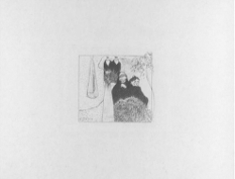Van Gogh Museum Journal 2000
(2000)– [tijdschrift] Van Gogh Museum Journal–
[pagina 28]
| |
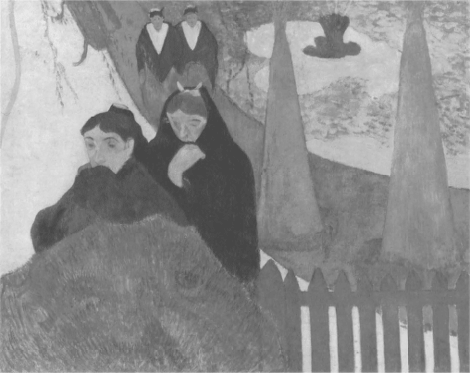 fig. 1
Paul Gauguin, Les vieilles filles (Arles) (The Arlesiennes, mistral), 1888, The Art Institute of Chicago | |
[pagina 29]
| |
Trading the visual: Theo van Gogh, the dealer among the artists
| |
[pagina 30]
| |
careers Vincent made contrasting comments about Theo. In the autumn of 1884 he told his younger brother that he considered him very much a Goupil man, shaped by the company's business ethic [465/380]. Yet in his last letter to Theo, written in July 1890, he stated that he considered him more than a dealer, and in fact someone who had exercised a creative influence on his painting [907/652]. To unravel what seems to be a paradox, we need to investigate some of the ways in which Theo interacted with artists and how he may have had an impact upon their work. | |
Replicas, the market and artistic identityReplicas - meaning in this context both copies and variants on works of art - were common in the 19th century, and for a variety of reasons. Some artists were fascinated by the creative act of reconsidering and reinvigorating a composition, perhaps even one initially designed many years before. Both Ingres and Degas, for example, relished the opportunity to work afresh on an earlier idea, at one level at least ‘in pursuit of perfection.’Ga naar voetnoot4 Another incentive was to satisfy the demands of collectors. Owning a major work was a matter of prestige, and a celebrated painter, such as Cabanel, might be requested to produce one or more replicas of an important painting - for example of his Birth of Venus, of which at least three were made.Ga naar voetnoot5 From another point of view, a variant on an established composition, a particular pose or grouping, or - more loosely - a typical subject, made for simplicity of effort on the part of both artist and dealer. Repeating existing ideas allowed the painter to produce his canvases more quickly, while for dealers it was easier to sell proven images that had the stamp of an accredited artist than those that deviated from the customary. This was a particularly ‘Goupil’ practice. A number of artists closely linked with the gallery regularly made pictures with this ‘production-line’ quality. This could take various forms. Bouguereau did not so much repeat images as adhere to a visual identity that was recognisably his own; Gérôme both recycled the same composition with minimal changes and crafted designs around well-worn poses; and Lhermitte produced replicas of the same composition in different media. This was the case with his First communion, a successful pastel of 1888 (present location unknown) that was copied in an oil painting two years late, both of them passing through Boussod & Valadon's books.Ga naar voetnoot6 Adjustments might be made in this kind of work, whether for aesthetic or commercial reasons, but the fundamental economic unit remained the same. There has been much discussion in recent art history about Monet's use of pairs and the origins of his series method.Ga naar voetnoot7 Certainly his practice of using pairs dates back to the 1860s, and the Gare Saint-Lazare paintings of 1877 are indeed a set of variants. The ‘multiple’ in his work thus pre-dates his association with Theo van Gogh, which effectively began in 1887. However, among the ten Antibes canvases the artist exhibited at his first one-man show at Boussod & Valadon in June 1888 was a pair of paintings representing the same bank of pine trees with the Mediterranean sparkling beyond: Pines trees at Cap d'Antibes (Switzerland, private collection) and Under the pines trees at the end of the day (USA, private collection).Ga naar voetnoot8 While these two pictures, painted in different lights, clearly belong to the plein-air rather than the studio tradition, they nevertheless use a repetitive mode not far from, say, Gérôme's: Monet has simply made a slight visual difference to what is essentially the same image. The artist repeated this gambit several times in the exhibition he shared with Rodin at the Galerie Georges Petit the following year.Ga naar voetnoot9 His increasing use of the replica tactic at just this time is surely significant. Neither Theo nor any other dealer may have explicitly asked him to paint these close variants, but the way this practice became entrenched during these months, as dealers competed fiercely for his pictures, may well have resulted from a new understanding that the art market was quite accustomed to the replica. Indeed, the suc- | |
[pagina 31]
| |
cessful sale of both versions of the pine tree motif during the course of the Antibes exhibition may well have whetted his appetite for the procedure - appropriately enough while showing ‘chez Goupil,’ the company so geared to marketing reproduced works of art.Ga naar voetnoot10 One might even examine Vincent's own creation of replicas in this light - again a subject about which much has been written.Ga naar voetnoot11 Vincent had various sources of inspiration and motives for producing copies and variants of his own work. Knowledge of his native Dutch tradition meant that he was well aware of the repetitive nature of, for example, Jan van Goyen's pictures, while motifs such as the bedroom were copied as gifts for his family rather than for any commercial purpose. That said, it is worth speculating on the extent to which Vincent's repetitions increased after he left Paris and settled in Provence. Of course, being far from family and friends - whom he naturally wished to see and own his work - it was necessary to make copies to send to them. But by making these copies he was also selecting what he saw as the key works in his ‘oeuvre,’ the images that he considered gave real substance to his achievement. In addition, the two years he had spent with Theo in Paris (March 1886-February 1888) had undoubtedly reminded him of the character and demands of the art market - in which he had himself worked as an employee of Goupil from 1869 to 1876. His time in Paris would have brought the market back into focus for him, not only through his daily contact with Theo, but also thanks to discussions with others in the business - from the colour merchant Tanguy to the Scottish dealer Alexander Reid. Indeed, Vincent's own neologism for the painters in his circle - the petit boulevard - was an economic one, differentiating the likes of Gauguin, Anquetin and himself, who had little or no market profile, from grand boulevard artists such as Monet and Degas, who had by now established themselves as saleable artists with major dealers. Vincent's knowledge of commercial practice, moulded by Goupil and sharpened on the petit boulevard, meant he recognised the value of having an identifiable ‘name’ and a recognisably individual set of motifs. The contemporary artists he most admired, among them Millet and Meissonier, had both. His determination to produce ‘an oeuvre’ came from his own artistic ambition and belief in himself. His desire to have it in some sense registered, as it were to patent his creative identity, was aided by the practice of the replica. By this means both his mother and sister in the Netherlands and Theo in Paris could have versions of his Bedroom (Amsterdam, Van Gogh Museum and Paris, Musée d'Orsay). Vincent's tactics for promoting his work combined the determination of the avant-garde with the habits of the more established art market. | |
The reproduction as a promotional gambitGoupil's business had its origins in the reproduction of works of art. By the 1880s the company had been at the forefront of this market for half a century, moving with the times and adopting new technologies such as photography and photogravure. The new proprietorship of Boussod & Valadon did not fundamentally change the company's core interest in this field; they merely altered its direction to echo changing tastes and markets. Thus while the old staple photogravures of the most popular paintings from the annual Salons were gradually falling out of circulation, Boussod and Valadon actively responded by entering the burgeoning market for illustrated magazines.Ga naar voetnoot12 One way or another, the reproduction of works of art remained central. Goupil's activities as a merchant of original works of art had followed his domination of the reproduction market, and came about thanks to an alliance with a Dutch art dealer, Vincent van Gogh - Theo and Vincent's ‘Uncle Cent.’ From the 1860s selling unique works and publishing reproductions went hand-in-hand. By purchasing a relatively cheap photo-gravure or other print, the client ‘bought in’ to the work of art reproduced; framed on the wall, the image revealed his admira- | |
[pagina 32]
| |
tion for that particular painter. A low level of art collecting was thus established. It helped the dealer's grander designs both by spreading the word that such-and-such an artist was popular (and in demand) and by encouraging the buyer to eventually move up the art market and acquire authentic works - perhaps beginning with original prints such as etchings, then works on paper and, ultimately, oil paintings. Gauguin included an album of 11 zincographs at the exhibition he staged at the Café Volpini, on the site of the Exposition Universelle, during the summer of 1889.Ga naar voetnoot13 These were available for purchase by visitors. A number of these prints either reproduced the compositions or adopted the motifs of Gauguin's paintings. Les vieilles filles (Aries), for example, was a simplified copy after a painting of the same title (figs. 1 and 2), while the Baigneuses bretonnes (Buenos-Aires, Museo Nacional de Bellas Artes) was a variant on a painting Theo had displayed at 19, Boulevard Montmartre in February 1888, Gauguin having placed it on commission there. The purpose of the zincographs was frankly practical and commercial. They were intended to promote Gauguin's work, disseminate his style, develop his market identity and encourage the purchase of his paintings. This was a procedure in the Goupil mode. It thus comes as no surprise to read in one of the artist's letters to Vincent that he had made the prints ‘afin de me faire connaître’ and that the project was undertaken ‘d'après le conseil et sous les auspices de votre frère.’Ga naar voetnoot14 And so we find Theo encouraging Gauguin and seeking to extend Boussod & Valadon's range into the most radical modern art by using one of the commercial devices he knew best: by linking the circulation of reproductions and the marketing of original works - the Goupil strategy par excellence. And one that Theo had used before: in April 1888 he had exhibited four lithographs by William Thornley after works by Degas, publishing a full album of 15 in 1889. He employed it again the next year, with the publication of 20 lithographs by Lauzet after paintings by Monticelli.Ga naar voetnoot15 Theo's method of promoting modern painting was thus deeply rooted in his company's long-standing marketing policy. | |
The artist-collector: art as investment and exampleAnother aspect of Theo's commercial activity that deserves attention is his sale of work by one artist to another. This side of his business operated in different ways. During the spring of 1887, for example, he sold a Degas drawing to Lhermitte and arranged for another Degas, a pastel over monotype, to be exchanged with Monet, apparently for a painting of Belle-Ile.Ga naar voetnoot16 Here Theo acted as an intermediary with Degas, who was increasingly curmudgeonly and a close acquaintance of neither Lhermitte's nor Monet's, and at the same time took practical steps to please two artists with whom Boussod & Valadon did business. On other occasions the reasons for one artist purchasing the work of another are still clearer. Jacques-Emile Blanche had known Degas as a boy, and had appeared in a group portrait the older artist had made on holiday in Dieppe in 1885.Ga naar voetnoot17 As a long-standing admirer of Degas's work it is not surprising he should have purchased the Dance rehearsal (Glasgow, The Burrell Collection) from Theo, a major painting of the mid-1870s.Ga naar voetnoot18 Likewise, Anna Boch was an appropriate buyer for Gauguin's Shepherd and shepherdess (Brussels, Musées Royaux des Beaux-Arts), which she acquired through Boussod & Valadon after seeing it at the 1889 Les XX exhibtion.Ga naar voetnoot19 As a neo-impressionist painter herself she would have appreciated the tapestry-like surface of Gauguin's canvas, while her brother, Eugène, knew the Van Gogh brothers personally. Both Blanche, son of a celebrated doctor, and Boch, daughter of a porcelain manufacturer, were wealthy, and bought paintings consistent with their own aesthetics. The pattern is slightly more perplexing with other sales to artists. In November 1888 the ledgers record the sale of another Gauguin painted at Pont-Aven, Pond by a road (present location unknown), to a certain Chéret.Ga naar voetnoot20 This was the poster designer Jules Chéret, several of whose vibrant images Theo had displayed at 19, Boulevard Montmartre that spring. Chéret's work - overtly commercial with its dynamic drawing and ostentatious colour - was utterly different from Gauguin's. So, too, was Henri | |
[pagina 33]
| |
Lerolle's. A well-off painter whose work balanced the influence of Puvis de Chavannes with a harmonious naturalism, Lerolle was then engaged in a mural decoration for the Hôtel de Ville in Paris: the Teaching and the Crowning of science.Ga naar voetnoot21 For him to buy in June 1889 Negresses at Martinique,Ga naar voetnoot22 one of Gauguin's exotic Caribbean paintings of 1887, again seems at least adventurous, even inconsistent. No doubt Chéret and Lerolle liked the pictures they bought. There may have been other persuasive forces at work as well, in Chéret's case the prudence of buying from a major gallery that was supporting his own work, and in Lerolle's the advice of his friend Degas, then keen on supporting Gauguin. However, commercial thinking probably also played a role. Both canvases cost only 300 francs. For these modest outlays - Monet's Antibes canvases were then selling for nine times the price - Chéret and Lerolle had made well-informed investments in new art. Just as Monet's prices had risen during the 1880s - climbing by another 20 per cent or so in Theo's hands during the course of 1887-88 - so, it might reasonably be expected, could Gauguin's. Theo's business approach with more modernist art seems to have been to encourage his clients to see it as a strategic investment, and he could note the examples of Daubigny in one generation and Monet in the next, painters whose reputations and prices had risen steadily, to prove his point. Chéret and Lerolle may well have followed his prompting and belief that Gauguin would be next in line. Gauguin himself considered sales to other artists very important, writing to Theo in July 1889 in the wake of the Lerolle purchase: ‘Je considère l'achat par les artistes comme le meilleur attendu que c'est la bonne démonstration du talent vis à vis le public.’Ga naar voetnoot23 Flattered he may have been, but both these artist-collectors were unlikely to have been entirely innocent of speculative considerations. The paintings Theo sold to artists seem on occasion to have had a significant impact on their own work. During the summer of 1888 John Singer Sargent worked at Calcot Mill, on the banks of the Kennet not far from Reading in Berkshire. There he painted a number of plein-air canvases,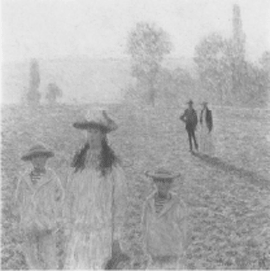 fig. 3
Claude Monet, La promenade (Five figures in a landscape), 1888, The Art Institute of Chicago including Dennis Miller Bunker painting at Calcot (Chicago, Terra Museum of American Art), which is almost square in format, quite varied in touch, mid-toned and with figures in contrasting poses. While visiting the Exposition Universelle in Paris in July 1889 Sargent went to his friend Monet's exhibition - shared with Rodin - at the Galerie Georges Petit. The works in the show obviously impressed him, for he purchased no. 111, La promenade (fig. 3), from Theo on 20 September - Boussod & Valadon having presumably lent the painting to Petit for the dual exhibition.Ga naar voetnoot24 Sargent's acquisition of that particular picture was practical. On his return from Paris he worked first at Fladbury | |
[pagina 34]
| |
 fig. 4
John Singer Sargent, Two girls with parasols at Fladbury, 1889, New York, The Metropolitan Museum of Art, Gift of Mrs Francis Ormond Rectory near Pershore. Canvases painted there show a development from those of 1888 apparently sparked off by the square La promenade. Two girls with parasols at Fladbury (fig. 4), for example, has a unified brushstroke and a higher keyed palette, and shares with the Monet a processional quality held in an almost square format.Ga naar voetnoot25 | |
Theo's exhibitions and their artistic repercussionsMore frequently, however, it was the paintings Theo had on show at 19, Boulevard Montmartre that had an impact on other painters' work. In January 1888 he staged the first one-man show of an impressionist artist at Boussod & Valadon. At least nine ‘articles,’ as Degas called them, were on display: pastels of female nudes at their toilette, some of them over a monotype base.Ga naar voetnoot26 Their influence on Gauguin is evident from the sheet of copies he made in his sketchbook (Paris, Musée d'Orsay), crucial evidence of this little-documented show. One of the pastels he copied also features in the Thornley album, while another - of a kneeling nude (private collection) - clearly lodged in his visual memory, for he made a variation on it with Otahi, painted in Tahiti five years later (private collection).Ga naar voetnoot27 In May-June 1890 Theo staged a Jean-François Raffaëlli show. This exhibition had considerable import because alongside paintings and drawings some unusual sculptures were also on display. Several pieces, such as the Young housemaid (private collection), were moulded as silhouettes within an irregular frame, thus creating an open-relief sculpture intended to hang on the wall like a picture. Critics commented appreciatively on this innovation, and these works seem also to have impressed Toulouse-Lautrec. His poster for Jane Avril's performances at the Jardin de Paris (Paris, Bibliothèque Nationale), designed in 1893, frames the image in a grey ‘metallic’ border to which the head of the musician's double-bass is linked, the overall effect being very close to Raffaëlli's silhouette-sculpture.Ga naar voetnoot28 It instances such as these, then, it seems that work Theo exhibited had a creative impact on the artists who saw it. By choosing to display challenging new art and by making 19, Boulevard Montmartre a centre for innovative work, Theo's gallery took on something of the role of a creative intermediary. | |
Summer 1890: Theo's stock, Vincent's responsesFinally, it is worth asking whether the pieces Theo had on view or in stock had any influence or impact on Vincent. Once again, there are various levels at which this may have occurred. Vincent knew Daubigny's work well, both from his own experience at Goupil's and from Theo's holdings and other examples he would have seen while in | |
[pagina 35]
| |
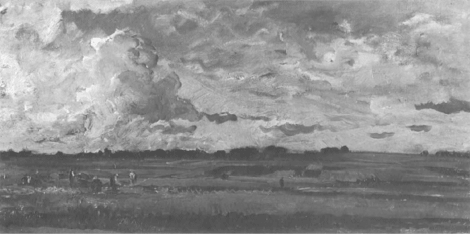 fig. 5
Charles Daubigny, Landscape with harvesters, c. 1875, Gouda, Stedelijk Museum Paris in 1886-88. Daubigny's canvases were a staple on the Paris art market, and the Goupil ledgers indicate that Theo handled almost 50, while other branches would have dealt in still more. This, coupled with the fact that the stockbooks often use only minimal titles (sometimes merely ‘paysage’!) and rarely give dimensions, means it is impossible to establish exactly which paintings Vincent might have seen. On his return from Provence in May 1890 Vincent spent four days in Paris before travelling on to Auvers. It is reasonable to assume that during this time he visited his brother's gallery. The Daubignys listed for this period are two riverscapes,Ga naar voetnoot29 but neither motif is relevant to the pictures Vincent produced during the next two months. Nevertheless, Auvers was the village where Daubigny had lived for many years, and the younger painter demonstrably associated aspects of his work there with his dead predecessor's, painting the house where his widow still lived and mentioning him in letters.Ga naar voetnoot30 We can only speculate whether Daubigny's broadly handled panoramas of the wheatfields to the north of Auvers, painted in an elongated format (fig. 5), were known to Vincent via the art market and had an impact on his work, or whether the two painters independently found similar solutions to representing that broad open terrain. What we do know, however, is that during the summer of 1890 Theo was trying to dispose of four over-door paintings of the seasons (Madrid, private collection) painted by Camille Pissarro in 1872 for his patron Gustave Arosa. On 5 July Theo wrote to Pissarro explaining that he had tried to sell them to the collector Emile Boivin, his mention of trying ‘de nouveau’ prompting one to speculate whether they had been at 19, Boulevard Montmartre in May when Vincent passed through.Ga naar voetnoot31 Pissarro's canvases are long, thin panoramas of the Vexin countryside, and had Vincent seen them they would also have provided him with | |
[pagina 36]
| |
 fig. 6
Camille Pissarro, Summer, 1872, Madrid, private collection 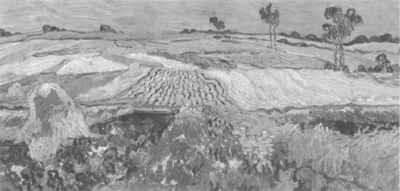 fig. 7
Vincent van Gogh, Wheatfields (F 775 JH 2038), 1890, Vienna, Österreichische Galerie an example of how to treat the extensive landscape around Auvers. In Summer (fig. 6) Pissarro employed broad zones of colour and an insistent perspective to create a sense of the expanse, much as Vincent did in Wheatfields (fig. 7), while his Autumn (fig. 8) represents crows wheeling over the crops in a way that reminds the modern viewer of the Wheatfield with crows (fig. 9). Such pictorial structures, it might be argued, were dictated by the lie of the land, while flocks of crows are merely typical of that particular habitat. Nevertheless, had Vincent seen Pissarro's Four seasons at Boussod & Valadon that May, they would have reminded him how landscapes with similar motifs can be orchestrated to vary in mood - as the ‘double square’ canvases made at Auvers so deliberately do - and also how observation of natural elements - in this case a flock of crows - might be used to accent deep space and to invest a canvas with emotion. Such connections and speculations may seem distant from Theo van Gogh's day-to-day activities as the manager of a busy branch of Boussod & Valadon in central Paris. The works of art he handled were, in business terms, | |
[pagina 37]
| |
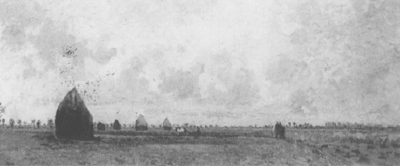 fig. 8
Camille Pissarro, Autumn, 1872, Madrid, private collection 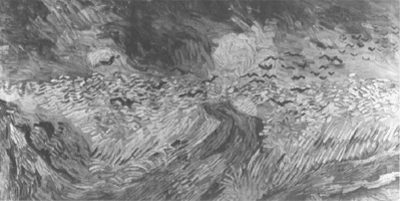 fig. 9
Vincent van Gogh, Wheatfield with crows (F 779 JH 2117), 1890, Amsterdam, Van Gogh Museum (Vincent van Gogh Foundation) merely commercial units to be bought at one price and sold at another, for profit. But they were also images: pictures to be looked at, admired, remembered, even used. Images, of course, were the stock-in-trade of the Goupil empire. It had been founded on and prospered through the transmission of them, whether printed or painted, replica or illustration, high art or low reproduction. Theo van Gogh served his company well by buying and selling works of art, by building up a clientele and by co-ordinating a successful business that involved established names such as Daubigny, rising stars like Monet, and challenging independents like Gauguin. There was, however, another aspect to his work, probably invisible to him at the time but more obvious to us today. In an oblique but significant way, Theo's activities had a creative impact on some of his artist contemporaries. This functioned not just by bringing work to their attention or encouraging them to buy; it might even have affected how they made their own works. In that sense, there was a creative side to Theo - just as Vincent had suspected. |
|


